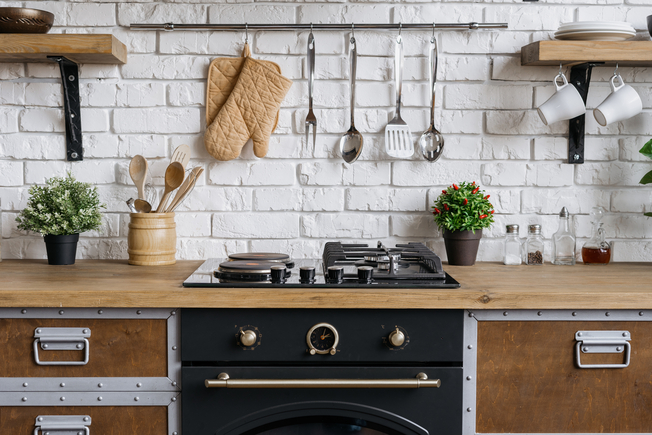
Making Your Apartment More Eco-Friendly: A Room-by-Room Guide
Feb 22, 2024
In December 2023, the United States Environmental Protection Agency (EPA) reported that the average household typically emits 14,020 pounds of carbon dioxide per year from electricity alone — plus more for natural gas, fuel, and so on.
Based on these numbers alone, we can see that there’s work to be done under our roofs when it comes to shrinking our carbon footprints. Luckily, a few small changes you make in your apartment can have big environmental impacts. Read on for our room-by-room guide to sustainable living at home.
The Kitchen
With so many paper and plastic products, electricity usage, and gas stove activity, the kitchen is a site for high levels of energy and food waste. In fact, the EPA estimates that the U.S. wastes the equivalent of 170 million metric tons of carbon dioxide just from food waste. Besides staying on top of your recycling and composting, here are other ways to go greener in your apartment kitchen.
Ditch paper and plastic. Paper towels, napkins, paper plates and bowls, oh my! The kitchen is a place where paper is often present. Because of the way paper products are manufactured and the harmful chemicals this process releases, your most eco-friendly option is to avoid them in the kitchen altogether. The same goes for plastic products like spray bottles, sponges, plastic bags, and food storage containers, which end up in landfills and can contaminate surrounding air and water with microplastics — tiny particles that come from the breakdown of plastic items and contaminate the air and oceans.
However, in your lifestyle, it may not be realistic to fully give them up. That doesn’t mean there aren’t better options. In lieu of using regular paper towels, for example, try paper towel alternatives that are tree-free or reusable. And for those big summer barbecues and or dreaded days of broken dishwashers, try 100% compostable dish alternatives. As for plastic, beeswax food storage options are all the rage in replacing Ziplocs and Tupperware. You can also use glass containers with bamboo lids. When deciding on cleaning products, consider reusable bottles and DIY disinfectants that you can make over and over in the same biodegradable or recycled bottles.
Be mindful when cooking. Just a few simple moves can make cooking more eco friendly. Keep lids on pots when boiling water to increase efficiency, use smaller appliances when possible instead of larger ones to save on electricity and gas, don’t let your leftovers go to waste, and use reusable coffee paraphernalia like mesh filters and travel mugs. Food scraps can be thrown into a compost bin instead of the trash (or, if you have vegetable scraps, those can be frozen, stored, and used to make broth or stock). When dealing with foil and parchment paper, try to reuse those, too. If you cover a dish with a piece of foil or parchment paper while cooking and it remains clean, simply fold it up and put it back where it came from for your next dish. Zero waste living is hard, but even attempting it and making a few mistakes along the way will make you more conscious about your energy consumption.
Ask your landlord to make some changes. Ideally, you’d want to replace your appliances with newer Energy Star models to create a sustainable home, but that’s up to your landlord. Ask your landlord for an upgrade in a friendly way if you notice your fridge and freezer aren’t keeping things cold enough or if your stove smells of gas, or if you have to run your dishwasher more than once to get your dishes clean. These are signs your appliances are old and that your apartment would benefit from more energy-efficient appliances. If your landlord won’t budge, try swapping out your incandescent lightbulbs for ones that use less energy, like LED bulbs. The Earth will thank you, and as an added bonus, you’ll likely see a difference on your energy bill.
The Bathroom
Don’t worry, we aren’t recommending reusable toilet paper or five-second showers. Here are some more reasonable switches for a greener bathroom.
Try a new kind of toilet paper. Toilet paper is a paper product that we can’t necessarily avoid that like we can with paper towels and paper plates. We can, however, be sure that we’re buying toilet paper that’s not made from virgin forest trees. Harvesting virgin trees is decimating forests that provide habitats and oxygen for the environment. Disrupt the tree-to-toilet pipeline by purchasing only recycled toilet paper or treeless toilet paper.
Watch your water usage. One of the quickest paths to an eco-friendly home is being conscious of water usage. Don’t let the water run while you’re brushing your teeth — there are even known benefits to dry brushing — and simply stop the faucet at a half-full sink if you’re shaving with a wet razor.
When it comes to the shower, it’s more difficult to use less water. After long hours at work and sandy days at the beach, sometimes that indulgent shower seems like just what you need. One thing you can do to be greener in these moments is take a colder long shower or a shorter hot shower. The average 10-minute shower uses 18 gallons of water, so maybe fill your kitchen sink and hand-wash your dishes instead of running the dishwasher if you’re planning to take a long, hot shower later. Replacing your current shower head with a low-flow showerhead is a more drastic step you can take to reducing water consumption.
Get greener products. The bulk of our cosmetic product usage happens in the bathroom. From hair to skin care, there are many ways to optimize your sustainability and still get the looks you want. Instead of running a hairdryer for a half hour to get the perfect blowout, try heatless curls and other clever hacks.
You can also buy bars of shampoo and conditioner instead of single-use plastic containers or look to brands that use recycled materials for their packaging. Many brands are selling reusable in-shower bottles with large under-counter recyclable refill bags for when your in-shower bottles run out.
You can also buy shampoo, conditioner, skincare, and makeup that’s refillable and sustainably produced. Be mindful of “greenwashing” when consuming these products — some companies make empty promises about the eco-consciousness of their brand. Do research on your favorite products, and don’t be afraid to use resources like ClearForMe to get into the specifics of cosmetic product ingredients. Clean products, clean conscience.
Living Spaces and Lifestyle
Besides spaces with very specific uses like the bathroom and kitchen, your apartment and lifestyle as a whole can always see improvement when it comes to living a greener life. Although cutting back on paper, plastic, and water usage is hugely important, there are other less obvious ways to be eco-conscious in your home.
The Bedroom
Go green in your sleep. In the bedroom, choosing organic mattresses and bedding, sustainable furniture and lighting, and adding plenty of house plants, thought to improve indoor air quality, will put you on your way to having a greener space. The same goes for the living room. When you’re picking out throw blankets and pillows, hunt for items made from sustainable materials to do your part to cut back on water pollution from the textile industry.
The Living Room
Shop local or thrift. Many of our consumer habits are in need of improvement. When it comes to buying, well, anything, it’s always better to shop from local sellers or buy secondhand items like clothes, furniture, rugs, dishware, and more. Estate sales can be a great place to find high-quality pieces in a way that’s less wasteful. If you buy something brand new from a manufacturer across the globe, you’re ultimately contributing to the billions of metric tons of carbon emissions the U.S. imports each year. The same goes for when you want to declutter; instead of throwing things out, donate them or resell them online.
Temperature matters. Temperature control is another significant element of keeping a greener apartment. According to the EPA, if you turn your thermostat down one degree in the winter and up one degree in the summer (just a smidge cooler or warmer than your ideal temperature), that tiny adjustment can save three percent on heat energy and six percent on air conditioning energy.
It also pays to make sure your home is efficient — especially if you have an older apartment, you can read here about how to seal the windows and doors and even use decor to your energy-efficiency advantage. Plus, you’ll end up saving money. Happier pockets, happier planet.
The Workspace
Unplug before you unwind. Taking a much-needed vacation from your home office? Simply unplug your electronics when you leave your apartment to use less energy. Otherwise, vampire electricity will continue to feed off your plugged-in outlets while you’re gone, wasting energy. It’s like telling your coworkers you’ll remain available via email while you’re on vacation — just unplug altogether so you can avoid wasted energy. You’ll notice a difference on your electricity bill, too.
The Laundry Room
Say goodbye to high heat. Pay attention to the settings on your washing machine and dryer. There are a few ways to up your sustainability game just by changing the way you do laundry. For one, wash your clothes in cold water, which is not only more sustainable but is also better for your clothes long term. When it’s time to dry, do the same: Drying clothes for longer on a lower heat setting is better for the environment than doing a shorter cycle on high heat. If you have clothes that don’t need a dry cycle, consider a good old fashioned clothesline in the summer if you have a private outdoor space or a drying rack.
Top metro areas
Atlanta Metro Apartments
1,474 apartments starting at $600/month
Austin Metro Apartments
1,402 apartments starting at $522/month
Baltimore Metro Apartments
735 apartments starting at $500/month
Boston Metro Apartments
5,088 apartments starting at $650/month
Charlotte Metro Apartments
908 apartments starting at $475/month
Chicago Metro Apartments
3,375 apartments starting at $400/month
Dallas Fort Worth Metro Apartments
2,743 apartments starting at $400/month
Houston Metro Apartments
1,070 apartments starting at $450/month
Las Vegas Metro Apartments
1,028 apartments starting at $670/month
Los Angeles Metro Apartments
4,777 apartments starting at $700/month
Miami Metro Apartments
571 apartments starting at $1,025/month
Milwaukee Metro Apartments
790 apartments starting at $500/month
New York Metro Apartments
2,144 apartments starting at $945/month
Orlando Metro Apartments
1,001 apartments starting at $550/month
Philadelphia Metro Apartments
1,767 apartments starting at $450/month
Phoenix Metro Apartments
1,551 apartments starting at $700/month
Pittsburgh Metro Apartments
1,083 apartments starting at $500/month
Portland Metro Apartments
1,735 apartments starting at $695/month
Raleigh Metro Apartments
808 apartments starting at $575/month
San Antonio Metro Apartments
1,035 apartments starting at $450/month
San Diego Metro Apartments
1,522 apartments starting at $590/month
San Francisco Metro Apartments
1,743 apartments starting at $850/month
Seattle Metro Apartments
1,525 apartments starting at $525/month
Tampa Metro Apartments
1,040 apartments starting at $725/month
Washington Metro Apartments
725 apartments starting at $550/month


